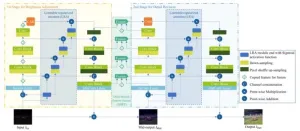(Press-News.org) Cells that die during inflammation send wound-healing messages
A study by the team of Prof. Kodi Ravichandran (VIB-UGent Center for Inflammation Research) and colleagues found that pyroptosis, a form of programmed cell death traditionally thought to be purely inflammatory, also plays a crucial role in promoting healing and tissue repair. This research, published in Nature, opens new avenues for understanding how our bodies respond to injury and could lead to innovative treatments for wounds and inflammatory diseases.
Dying cells
About a billion cells die in our bodies every day. Most of these cells are killed by a process called apoptosis, which is a form of cellular maintenance that keeps us healthy. However, under the influence of pathogens or inflammatory triggers, cells can die in a process called pyroptosis. As the name suggests (pyro means fire), pyroptosis causes significant inflammation, which helps the body clear infections, but also causes severe tissue damage.
“Cell death by pyroptosis has so far only been regarded as inflammatory and damaging in nature, but our work suggests that, besides tissue-damaging factors, pyroptosis also releases beneficial molecules that encourage wound healing, which could lead to new treatments for dealing with chronic wounds or inflammation,” says Prof. Kodi Ravichandran (VIB-UGent), one of the lead authors of this study.
Inflammation and healing
Whenever we face an injury or infection, our body responds by mounting an immune response, which results in inflammation clearing the infection. However, when the inflammation is not resolved in a timely or controlled manner, there can be excessive tissue damage. Cells undergoing pyroptosis contribute to this inflammation by releasing inflammatory molecules.
However, new research by the team of Prof. Kodi Ravichandran and colleagues finds that these pyroptotic cells also release molecules that can encourage wound healing.
“To our surprise, using cell culture and mouse model systems, the molecules secreted by pyroptotic cells are unique. These molecules induce significant gene expression changes in nearby healthy immune cells (macrophages) that promote healing and tissue repair. So, pyroptosis presses both the accelerator and the brake; on the one hand inflammatory cytokines released from pyroptotic cells cause inflammation, while metabolites and oxylipins in the secretome help the tissue to heal itself” says Dr. Parul Mehrotra, a senior and first author on the study (VIB-UGent, now at Indian Institute of Technology, Delhi).
Closing wounds
One of the key wound-healing molecules that the researchers identified is prostaglandin E2, known for its role in pain and tissue regeneration.
Dr. Sophia Maschalidi (VIB-UGent), co-first author of this work, says: “Our experiments revealed that the secreted molecules from dying cells, known as the pyroptotic secretome, can significantly boost the body's ability to repair damaged tissues even when inflammatory molecules are present.”
This study suggests that current strategies to develop treatments by blocking pyroptosis may need to be reconsidered. While this can prevent damage, it might also inhibit the release of essential molecules that aid in tissue repair. Instead, the newly identified small molecules and lipids from the pyroptotic secretome could be harnessed to develop new therapies, offering new hope for patients suffering from chronic wounds or inflammatory diseases.
END
Cells that die during inflammation send wound-healing messages
2024-09-11
ELSE PRESS RELEASES FROM THIS DATE:
Risk of secondary cancers after CAR T therapy may be similar to risk after other cancer treatments
2024-09-11
Bottom Line: The frequency of second primary malignancies (SPMs) arising in cancer survivors following treatment with CAR T-cell therapy was statistically comparable to the frequency of SPMs following other standard-of-care therapies, according to a systematic review and meta-analysis.
Journal in Which the Study was Published: Clinical Cancer Research, a journal of the American Association for Cancer Research (AACR)
Author: Kai Rejeski, MD, a visiting investigator and research fellow in the Adult Bone Marrow Transplant Service at Memorial Sloan Kettering Cancer Center.
Background: In January 2024, the U.S. Food and ...
Enhance and revise for better low-light image enhancement
2024-09-11
With the development of intelligent era, information captured in low-light environments has become increasingly vital. Low-light enhancement technology is now a significant research topic in the domain of machine vision. Designing a robust low-light enhancement algorithm can not only improve the contrast of images, but also restore color and texture details, so as to obtain more distinct and accurate low-light scene information.
The team led by Prof. Danhua Cao from Huazhong University of Science and Technology (HUST), ...
Multiple ways to evolve tiny knee bone could have helped humans walk upright
2024-09-11
The evolution of bones in primates’ knees could have implications for how humans evolved to walk upright, a new study has found.
Researchers from King’s College London analysed the presence of the lateral fabella, a bone in the knee the size of a sesame seed, in 93 different species of primates.
They found that while most primates have these bones, they are often absent in hominoids, the group of primates that humans belong to alongside chimpanzees, gorillas, gibbons, and others.
Yet ...
UBCO study explores access to psychedelics for therapeutic use
2024-09-10
Feeling safe and comfortable are key when discussing your health and wellbeing with your primary care provider.
However, that feeling of comfort and safety can’t be taken for granted among many people who have turned to psychedelic substances—including psilocybin—to help control their symptoms of depression, anxiety or PTSD. Now, a team of UBC Okanagan researchers in the Irving K. Barber Faculty of Arts and Social Sciences has published a study looking into patient perspectives and potential issues when it comes to discussing psychedelics for therapeutic use with their physicians.
Dr. Michelle St. Pierre conducts ...
Lower diligence level linked to higher cardiovascular disease risk in type 2 diabetes
2024-09-10
People with type 2 diabetes, who display lower levels of diligence, may have a significantly higher risk of developing cardiovascular disease with which diabetes is strongly associated, finds research published in the open access journal BMJ Open Diabetes Research & Care.
While certain personality traits may influence cardiovascular disease risk, adopting a healthy lifestyle is still beneficial, irrespective of diligence level, the findings show.
Effective management of type 2 diabetes ...
Statins cost effective and linked to better health outcomes in older people
2024-09-10
Statin treatment is cost effective and linked to better health outcomes in older people with or without previous cardiovascular disease, although the risk reductions were substantially smaller in the latter, reports a modelling on the lifetime benefits of these drugs among the over-70s, published online in the journal Heart.
The findings back consideration of these drugs for most over-70s, say the researchers.
Statins are used extensively to ward off heart attacks and strokes in middle-aged people, ...
Abdominal fat linked to widespread chronic pain, especially in women
2024-09-10
Excess abdominal fat is associated with widespread chronic pain, particularly in women, finds the first study of its kind, published in the open access journal Regional Anesthesia & Pain Medicine.
Reducing excess fat deposits in the abdomen may help reduce chronic musculoskeletal pain, especially if it’s experienced at multiple body sites, suggest the researchers.
Previously published research has shown that obesity is associated with musculoskeletal pain, but it’s not known if excess fat tissue is linked to chronic musculoskeletal pain and at multiple body sites, ...
Wearable brain imaging device shines a light on how babies respond in real-world situations
2024-09-10
A new technology which uses harmless light waves to measure activity in babies’ brains has provided the most complete picture to date of brain functions like hearing, vision and cognitive processing outside a conventional, restrictive brain scanner, in a new study led by researchers at UCL and Birkbeck.
The wearable brain imaging headgear, which was developed in collaboration with UCL spin-out Gowerlabs, found unexpected activity in the prefrontal cortex, an area of the brain that processes emotions, in response to social stimuli, appearing to confirm ...
"Cuddle hormone" oxytocin may provide pain relief and help curb harmful opioid use
2024-09-10
In the midst of America’s growing opioid crisis, a much healthier alternative to long-term pain management is emerging — one affectionately known as “the cuddle hormone,” or oxytocin.
University of Florida researchers are currently investigating whether a synthetic version of this naturally-occurring human hormone can be used in conjunction with prescription drugs to help curb opioid addictions, especially in susceptible older adults. An interdisciplinary research team is conducting the two-year study, with $414,375 in funding from the National ...
Study reveals mechanism that activates glucose production in the liver in response to stress
2024-09-10
A study led by Brazilian researchers has produced a detailed description of the morphology of the nerves in the liver and how they control production of glucose when the organism is under stress. This process is known as hepatic gluconeogenesis. It is a key metabolic function of the liver that helps maintain a normal blood sugar level, especially when fasting and at times of high energy needs.
An article on the study, which entailed experiments with mice, is published in the journal Metabolism. According to the authors, the sympathetic nerves that stimulate the release of noradrenaline in the liver helped ...


